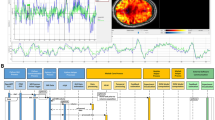Abstract
Subject motion is still the major source of data quality degradation in functional magnetic resonance imaging (fMRI) studies. Established methods correct motion between successive repetitions based on the acquired imaging volumes either retrospectively or prospectively. A fast, highly accurate, and prospective real-time correction method for fMRI using external optical motion tracking has been implemented. The head position is determined by means of an optical stereoscopic tracking system. The method corrects motion during the acquisition of an fMRI time series on a slice-by-slice basis by continuously updating the imaging volume position to follow the motion of the head. This method allows the measurement of fMRI data in the presence of significant motion during the acquisition of a single volume. Even without intentional motion, fMRI signal stability is maintained and higher sensitivity to detect activation is achieved without reducing specificity. With significant motion, only the proposed approach allowed detection of brain activation. The results show that the new method is superior to image-based correction methods, which fail in the case of fast or excessive motion.
Similar content being viewed by others
References
Bullmore ET, Brammer MJ, Rabe-Hesketh S, Curtis VA, Morris RG, Williams SC, Sharma T, McGuire PK (1999) Methods for diagnosis and treatment of stimulus-correlated motion in generic brain activation studies using fMRI. Hum Brain Mapp 7(1):38–48
Hajnal JV, Myers R, Oatridge A, Schwieso JE, Young IR, Bydder GM (1994) Artifacts due to stimulus correlated motion in functional imaging of the brain. Magn Reson Med 31(3):283–291
Friston KJ, Ashburner J, Poline JB, Frith CD, Frackowiak RSJ (1995) Spatial realignment and normalization of images. Hum Brain Mapp 2:165–189
Thesen S, Heid O, Mueller E, (2000) Prospective acquisition correction for head motion with image-based tracking for real-time fMRI. Magn Reson Med 44(3):457–465
Friston KJ, Williams S, Howard R, Frackowiak RS, Turner R (1996) Movement-related effects in fMRI time-series. Magn Reson Med 35(3):346–355
Jezzard P, Clare S (1999) Sources of distortion in functional MRI data. Hum Brain Mapp 8(2–3):80–85
Andersson JL, Hutton C, Ashburner J, Turner R, Friston K (2001) Modeling geometric deformations in EPI time series. Neuroimage 13(5):903–919
Fu ZW, Wang Y, Grimm RC, Rossman PJ, Felmlee JP, Riederer SJ, Ehman RL (1995) Orbital navigator echoes for motion measurements in magnetic resonance imaging. Magn Reson Med 34(5):746–753
Tremblay M, Tam F, Graham SJ (2005) Retrospective coregistration of functional magnetic resonance imaging data using external monitoring. Magn Reson Med 53(1):141–149
Buhler P (2004) An accurate method for correction of head movement in PET. IEEE Trans Med Imaging 23(8):1176–1185
Beach R (2004) Feasibility of stero-infrared tracking to monitor patient motion during cardiac SPECT imaging. IEEE Trans Nucl Sci 51(5):2693–2698
Zaitsev M, Dold C, Sakas G, Hennig J, Speck O (2006) Imaging of freely moving objects: prospective real-time motion correction using an external optical motion tracking system. Neuroimage (in press)
Hillenbrand D, Lo K, Punchard W, Reese T, Starewicz P (2005) High-order MR shimming: a simulation study of the effectiveness of competing methods, using an established susceptibility model of the human head. Appl Magn Reson 29:39–64
Zaitsev M, Hennig J, Speck O (2004) Point spread function mapping with parallel imaging techniques and high acceleration factors: fast, robust, and flexible method for echo-planar imaging distortion correction. Magn Reson Med 52(5):1156–1166
Armstrong B (2002) RGR-3D: simple, cheap detection of 6-DOF Pose for tele-operation, and robot programming and calibration. IEEE Int Conf Robo Autom, Washington
Pruessmann KP, Barmet C, , De Zanche N (2005) Improving image reconstruction by magnetic field monitoring. ESMRMB; Basle. p 193
Author information
Authors and Affiliations
Corresponding author
Rights and permissions
About this article
Cite this article
Speck, O., Hennig, J. & Zaitsev, M. Prospective Real-Time Slice-by-Slice Motion Correction for fMRI in Freely Moving Subjects. Magn Reson Mater Phy 19, 55–61 (2006). https://doi.org/10.1007/s10334-006-0027-1
Received:
Accepted:
Published:
Issue Date:
DOI: https://doi.org/10.1007/s10334-006-0027-1




